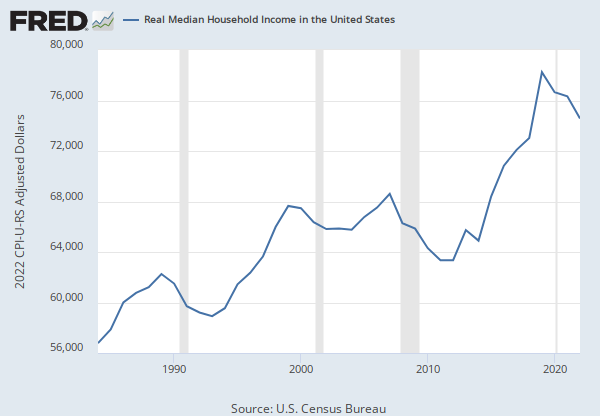Observations
Q4 2024: 13.40000 | Percent of Aggregate, Not Seasonally Adjusted | Quarterly
Updated: Mar 21, 2025 2:08 PM CDT
Observations
| Q4 2024: | 13.40000 | |
| Q3 2024: | 13.40000 | |
| Q2 2024: | 13.40000 | |
| Q1 2024: | 13.40000 | |
| Q4 2023: | 13.40000 |
Units:
Frequency:
Write a custom formula to transform one or more series or combine two or more series.
You can begin by adding a series to combine with your existing series.
Now create a custom formula to combine or transform the series.
Need help?
For example, invert an exchange rate by using formula 1/a, where “a” refers to the first FRED data series added to this line. Or calculate the spread between 2 interest rates, a and b, by using the formula a - b.
Use the assigned data series variables (a, b, c, etc.) together with operators (+, -, *, /, ^, etc.), parentheses and constants (1, 1.5, 2, etc.) to create your own formula (e.g., 1/a, a-b, (a+b)/2, (a/(a+b+c))*100). As noted above, you may add other data series to this line before entering a formula.
Finally, you can change the units of your new series.
Add the minimum, maximum, and average calculations of selected bars to the graph
Write a custom formula to transform one or more series or combine two or more series.
You can begin by adding a series to combine with your existing series.
Now create a custom formula to combine or transform the series.
Need help?
For example, invert an exchange rate by using formula 1/a, where “a” refers to the first FRED data series added to this line. Or calculate the spread between 2 interest rates, a and b, by using the formula a - b.
Use the assigned data series variables (a, b, c, etc.) together with operators (+, -, *, /, ^, etc.), parentheses and constants (1, 1.5, 2, etc.) to create your own formula (e.g., 1/a, a-b, (a+b)/2, (a/(a+b+c))*100). As noted above, you may add other data series to this line before entering a formula.
Finally, you can change the units of your new series.
Add the minimum, maximum, and average calculations of selected bars to the graph
Data in this graph are copyrighted. Please review the copyright information in the series notes before sharing.
Notes
| Title | Release Dates | |
|
|
||
| Share of Real Estate Held by the Top 1% (99th to 100th Wealth Percentiles) | 2019-06-21 | 2025-03-21 |
| Source | ||
|
|
||
| Board of Governors of the Federal Reserve System (US) | 2019-06-21 | 2025-03-21 |
| Release | ||
|
|
||
| Distributional Financial Accounts | 2019-06-21 | 2025-03-21 |
| Units | ||
|
|
||
| Percent of Aggregate | 2019-06-21 | 2025-03-21 |
| Frequency | ||
|
|
||
| Quarterly | 2019-06-21 | 2025-03-21 |
| Seasonal Adjustment | ||
|
|
||
| Not Seasonally Adjusted | 2019-06-21 | 2025-03-21 |
| Notes | ||
|
|
||
|
The Distributional Financial Accounts (DFAs) integrate two data products produced by the Federal Reserve Board: the Financial Accounts of the United States, which provide quarterly data on aggregate balance sheets of major sectors of the U.S. economy, and the Survey of Consumer Finances (SCF), which provides comprehensive triennial microdata on the assets and liabilities of a representative sample of U.S. households. Information on the data collection process can be found at the Board of Governors (https://www.federalreserve.gov/releases/efa/efa-distributional-financial-accounts.htm)." |
2019-06-21 | 2025-03-21 |
Release Tables
Related Data and Content
Data Suggestions Based On Your Search
Content Suggestions
Related Categories
Releases
Tags
Permalink/Embed
modal open, choose link customization options
Select automatic updates to the data or a static time frame. All data are subject to revision.









